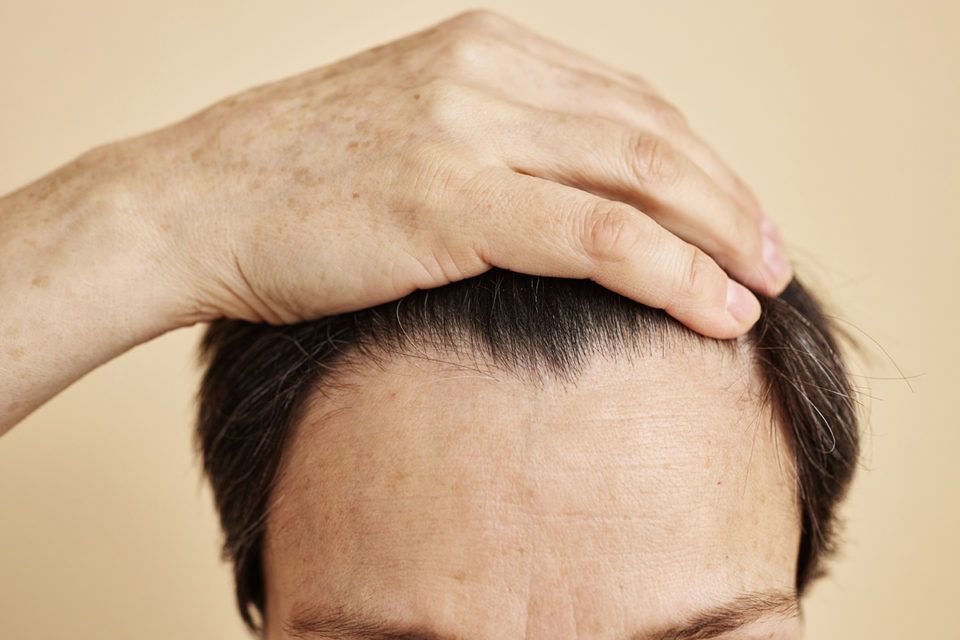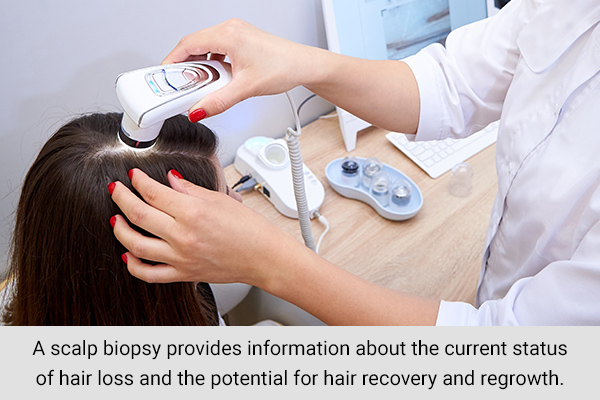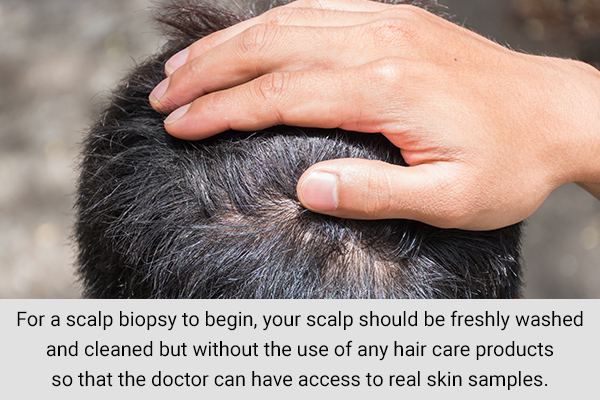Scalp Biopsy for Hair Loss: What You Should Know

Hair loss is a typical problem for lots of men and women of all ages all all over the environment, irrespective of their backgrounds and ages.
Hair decline can come about from many fundamental causes and is frequently attributed to problems such as pattern baldness, chemical solutions, excessive grooming, continual tension, autoimmune problems, and lousy nutritional profile.
Nevertheless, most normally, you really don’t know the specific purpose for your hair loss. This is when you consider your doctor’s aid.
The negative news is, in some cases, even a expert is not able to figure out the cause of your hair decline simply because your regime exams and blood profile occur out to be usual.
This is when a scalp biopsy comes in helpful!
When hair begins thinning and falling without the need of a distinct cause, your health care service provider may perhaps check with you to get a scalp biopsy to discover about the very issue that is causing your hair to lose and also to recommend the most efficient cure for the same. (1)
While the imagined of a scalp biopsy could seem to be unsettling and terrifying for quite a few, the treatment is usually speedy and will involve nominal distress.
This write-up will existing what scalp biopsy is and how correctly it diagnoses hair reduction.
What Is a Scalp Biopsy?
A scalp biopsy is a rather very simple healthcare technique used to diagnose many scalp disorders. It is invasive as it includes using a smaller pores and skin sample from your scalp for screening. (2)
Healthcare specialists use unique strategies, this kind of as punch biopsies (working with a circular tool) or shave biopsies (shaving a small section of skin) to search into the trigger of your hair decline. These little samples, smaller than a pencil eraser, are sent to a specialized skin pathologist for investigation. (3)
The biopsy allows health care companies to correctly diagnose scalp problems, like androgenetic alopecia, by inspecting the hair follicles for problems or counting them.
It can also expose indicators of hair challenges relevant to autoimmune disorders or scalp disorders.
What Does a Scalp Biopsy Tell You About Hair Decline?

A scalp biopsy can explain to your medical professional a good deal about your hair and scalp health and fitness.
Initially, it will allow for a closer examination of the hair follicles, determining any injury that may well be creating the hair reduction. It supplies a depend of your hair follicles and hair.
Second, it can help recognize the presence of scalp infections or skin challenges that may possibly influence the scalp and so can be the underlying reasons for hair reduction. (3)
Additionally, it is fantastic for detecting inflammatory responses, which are from time to time to be blamed for hair loss. Addressing them can assist gradual or discourage hair shedding. (4)(3)
Lastly, a scalp biopsy delivers info about the existing status of hair reduction and the opportunity for hair recovery and regrowth.
In specific scenarios, it’s also useful when strange moles or skin growths are current on the scalp to ascertain if health care attention is required or not.
Scientific Evidence for Scalp Biopsy Precision in Diagnosing Hair Decline
Exploration has proven that scalp biopsies are critical for accurately diagnosing the result in of hair decline.
Diverse sections can be examined to diagnose diverse hair reduction elements.
Horizontal portion biopsies are extra beneficial in noncicatricial alopecia situations, while vertical section biopsies are helpful for cicatricial alopecia. (5)
Horizontal sections help decide follicular counts, density, and ratio, earning them necessary for disorders these kinds of as telogen effluvium and androgenetic alopecia. On the other hand, they may perhaps be considerably less valuable in other conditions, these types of as discoid lupus erythematosus.
Some newer approaches, such as the “HoVert system,” present guarantee in simplifying diagnostics, but further exploration is necessary to affirm their performance. (5)
In sum, scalp biopsy can be a quite self-adequate and promising way of diagnosing hair decline complications.
When Is a Scalp Biopsy Accomplished?
A scalp biopsy can be done in several conditions to affirm the analysis of hair problems. It is valuable in differentiating amongst different brings about of hair decline.
Some common indications of a scalp biopsy involve: (3)
- Differentiating in between feminine-pattern hair loss and continual telogen effluvium: Feminine-sample hair decline is gradual, whilst serious telogen effluvium causes abnormal shedding for months.
- Differentiating involving chronic diffuse alopecia areata and male-sample hair decline: Persistent alopecia areata is lengthy expression and affects different regions, whilst male-sample hair loss sales opportunities to receding hairlines or bald crowns in men.
- Lymphocytic scarring alopecias: Situations ensuing from swelling and scarring of the hair follicles
- Trichotillomania: Compulsive hair pulling foremost to hair decline
- Unusual scalp lumps or bumps
- Test-up for hair transplant
What Comes about Throughout a Scalp Biopsy?


A scalp biopsy is a pretty simple and pain-free method that is nothing to be scared of.
For a scalp biopsy to start, your scalp must be freshly washed and cleaned but devoid of the use of any hair care products and solutions so that the physician can have obtain to serious skin samples.
After this, your position is pretty much performed. Almost everything will now be performed by the expert, who will start by implementing a community anesthetic to the scalp so that you experience no discomfort or ache. (4)
When the anesthesia is on, the medical professional will get a sample of your scalp and also some hair follicles employing frequent gear these kinds of as a scalpel or punch resource. The sample taken is pretty smaller and not even the sizing of a pea.
Right after the sample has been taken, the health practitioner will cover the area of the scalp from where the sample was taken using a bandage and will hand you a checklist of guidelines for post-biopsy care.
The health care provider will send your sample to the lab for investigation. Primarily based on the lab final results and reports, they will attract conclusions about the variables that lead to your hair reduction. (6)
What Are the Other Methods of Hair Decline Analysis?
There are quite a few out there strategies for hair reduction diagnosis other than scalp biopsy, and they incorporate: (2)
- Questionnaire: Solution inquiries about your hair and any troubles you have noticed.
- Each day Hair Counts: Count how lots of hairs you eliminate in a working day.
- Standardized Clean Check: See how much hair falls out when washing.
- 60-Second Hair Rely: Count the hairs that fall out in a minute.
- World Photos: Photographs of your scalp for evaluation.
- Dermoscopy: Look at the scalp and hair with a specific unit.
- Hair Body weight: Weigh hair samples to evaluate loss.
- Contrasting Felt Assessment: Evaluate hair reduction utilizing a contrasting felt pad.
- Phototrichogram: Use shots to study hair advancement and decline.
- TrichoScan: Examine hair with a specialised machine.
- Polarizing and Surface area Electron Microscopy: Use state-of-the-art microscopy to research hair.
- Trichogram and Unit Location Trichogram: Evaluate hair loss through specific assessments.
Most-Asked Thoughts
Is a scalp biopsy a unpleasant course of action?
Health care gurus use an anesthetic to make it as pain-free as feasible.
Are there side effects of a scalp biopsy?
Scalp biopsies are not often at any time involved with facet effects.
How before long can I count on the final results?
You will obtain your results centered on how rapidly your lab provider is. It can be within a few times to a couple of months.
Is a scalp biopsy a thing anyone can get?
You can only get a scalp biopsy if your doctor thinks it’s vital.
Final Word
Scalp biopsies assist determine out why your hair is slipping out when other tests cannot.
Through the procedure, your physician will take a small piece of skin and some hair follicles from your scalp. It’s not a distressing process, as they use an anesthetic.
This sample tells them if your hair decline is thanks to harmed follicles, bacterial infections, or swelling. It also displays the potential for hair to improve back again.
Exploration supports the success of scalp biopsies in diagnosing hair decline.